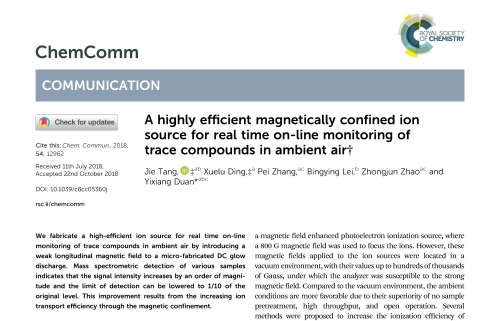Recently, XIOPM State Key Laboratory of Transient Optics and Photonics conducted a joint study with Sichuan University and found that magnetic field, under the atmospheric normal pressure, could effectively constrain ion’s propagating properties. Based on the research, they developed a highly efficient magnetically confined miniature mass spectrum ion source for monitoring of trace compounds in ambient air. Relevant research has been published on the internationally authoritative journal Chemical Communications in the form of news. (IF: 6.3 @2017;Nature Index: Chemical Category 1)

The DC glow discharge microplasma source has unique technical advantages and broad application prospects in the fields like chemical analysis and environmental monitoring due to its discharge stability and plasma non-equilibrium characteristics. Mass spectrometry with high sensitivity, high selectivity and fast response has become one of the core technologies in the field of analytical chemistry, and plays a huge role in the qualitative and quantitative detection of trace species. People have long been working to improve the analytical performance of mass spectrometers. The atmospheric ion source, as the core component of the mass spectrometer, is mainly used to desorb and ionize the sample to produce gaseous sample ions. The ability of ionizing the sample efficiently and transporting the ionized analyte to the detection inlet largely determines the analysis sensitivity of the entire mass spectrometer.
In an atmospheric environment, an ionized analyte is generally transported to a mass spectrometer detection inlet by an air flow, which causes a large part of the ions to escape into the ambient atmosphere and lost, resulting in low transmission efficiency. In order to improve the ion transport efficiency, the research team, based on the finding that magnetic field could effectively constrain ion’s propagating properties under atmospheric normal pressure, proposed a new method that longitudinal magnetic field constrains ion’s transport under atmospheric environment and developed an atmospheric magnetically-constrained DC glow discharge mass spectrometer ion source for trace species detection and analysis. The most important parts are: 1) In the weak electric field, the airflow and the Lorentz force act together to make the ion spiral and reduce the probability of escaping; 2) On the foundation of the collective collision effect between ions and environmental molecules such as nitrogen and oxygen, the method could further reduce the confinement radius, so that more ions could be transported to the detection inlet and the ion transportation efficiency is increased. Through mass spectrometry, the method can successfully increase the intensity of the sample mass spectrometry signal by 10 times, and reduce the detection limit to 1/10 of the former, so that the detection limit of certain organic samples to be tested may reach dozens of PPt. The research provides a more reliable detection method for chemical analysis and environmental monitoring, and opens up new research directions for the application of low temperature plasma. It was funded by Ministry of Science and Technology of the People’s Republic of China, National Natural Science Foundation of China and Young Scholar of West China Program, CAS.

Atmospheric magnetically-confined ion trajectory and mass spectrometry of the sample aspirin solution
In recent years, State Key Laboratory of Transient Optics and Photonics has realized theoretical and technological breakthroughs in basic plasma research field and achieved a series of original scientific payoffs. The research team firstly introduced the concept “lens beam expanding” into the field of low-temperature plasma, and proposed the “electric field lens model” to establish a new basic theory on uniform and diffuse discharge of the atmosphere. The achievement was published on the international famous academic journal of applied physics JAP (2017), appearing on the cover and highlight article. In addition, the research team has successively published 8 papers of the field of low-temperature plasma on Nature Index world top-class academic journals (CC&APL), and APL accepted one of the papers 6 days only after its submission. All of the above have laid a solid foundation for XIOPM for its development in plasma discipline.
The Nature Index is a database launched by Nature Publishing Group in November 2014. It plays an important role in evaluating the output of international standard academic achievements of scientific research institutions. The analysis of the natural index is based on the calculation and statistics of the number of research papers published the year before by scientific research institutions on 82 journals of nature science, including Nature series, Science, Cell, PNAS、PRL、PRX、APL、JACS、CC and etc. It tracks information of companies of the authors of about 60,000 high-quality research papers, covering about more than 20,000 research institutions around the world. The global in-service scientists form two independent panels to choose the 82 source journals which are divided into four categories including chemistry, earth and environmental science, life science and physics. Although the 82 journals account for only 0.6% of the journals in the world, their citations account for 30% of the total citations of the natural science journals. The papers published in these journals represents, to a certain extent, the high level of the research results around the world.
Title of the Paper:
A highly efficient magnetically confined ion source for real time on-line monitoring of trace compounds in ambient air
Full Text Link:
https://pubs.rsc.org/en/content/articlelanding/2018/cc/c8cc05360j#!divAbstract


